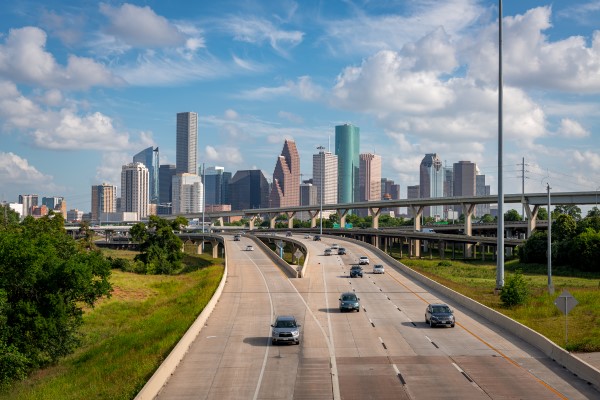Post-Pandemic Traffic Picking Up in Large U.S. Cities, But Downtown Traffic Remains Down
Published Oct 26, 2022 by A.J. Mistretta
Traffic in the nation’s biggest cities has largely returned to pre-pandemic levels, but a recent report suggests traffic remains more than 25% below pre-pandemic levels in the downtowns of those cities.
Vehicle miles traveled (VHT) in April 2022 across the nation’s 10 largest cities was up 4% from where it stood in April 2019, but miles traveled in the downtowns of the same cities remained down 27% compared to two years ago, according to the report from StreetLight Data.
The report also used patterns in Houston and New York City as a case study. To do so, the authors measured volume on 10 select road segments in Downtown Houston and Lower Manhattan—both CBDs dominated by office space—and compared the two. Morning traffic heading into both areas has decreased since pre-COVID, but in Manhattan trips originating more than 50 miles away are down 40% while trips from closer-in New York neighborhoods (10 miles or less) are down roughly 30%. By comparison, Houston trips from more than 50 miles away are down by approximately 26%.
According to the report’s authors, “There seems to be a clear tradeoff happening: For those with more manageable distances to travel, the pull of downtown is strongest. But for those coming from much farther away, downtown office culture holds the least sway.”
Housing density plays a big role as well. The report points out that while more than 60,000 people live in lower Manhattan, just 15,000 live in the Houston CBD. But for both downtowns, “the data consistently show a drop in peak a.m. traffic volume, which suggests not only that fewer people are commuting to offices downtown, but also signals that…downtown attractions are seeing fewer visitors, causing economic centers to suffer.”
In examining vehicle hour delays, or how long motorists are spending in their cars, Houston is seeing a more rapid return to afternoon traffic delays—just 13% below where these delays stood in 2019—than other major metros, which are seeing morning delays grow faster. “People who are coming back into the office seem to be doing so later in the day — and based on other StreetLight analyses, staying fewer hours than the historic nine-to-five,” the report concludes.
Based on key card access data analyzed across the 10 markets, more office workers have returned to in-person work in Houston than the other cities. But nationwide, many office workers, especially those with the longest distance to travel, still aren’t returning to downtowns. “For those who are coming into town, they are traveling later in the day and appear to be limiting their hours spent in the city core,” the report said. “If cities want to spark economic activity, they will need to think beyond nine-to-five culture.”
Learn more about living in Houston.
 The Houston Report
The Houston Report

















